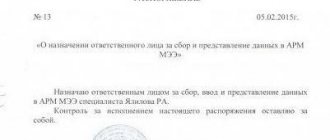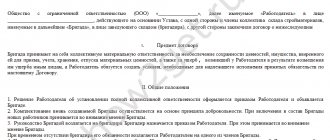Vicarious liability is payment for the debts of a partner company subject to its own insolvency. In simple terms, this is the collection of funds that an organization owes to creditors from a person who participated in the debtor’s transactions or took part in its management. Today, the “subsidy” is an effective tool for collecting taxes and replenishing the country’s budget. The days of unpunished dumping of a company's property and writing off debts in bankruptcy are long gone. The law has become stricter, and dishonest behavior by managers of a pre-bankrupt business can result not only in the loss of the company’s property, but also in personal wealth.
What it is
In Russian legislation, subsidiary liability is defined as additional to the liability that the debtor bears to the creditor. For example, if a company does not have enough assets to pay off debts, by a court decision, the debt will be paid off by CDLs (persons controlling the debtor) - partners who, during the last 3 years before the onset of insolvency, were involved in transactions that were recognized as dubious and caused harm to the organization .
For example, while he was director of Trade LLC, I. I. Ivanov transferred 23 million rubles to the account of Fakel LLC without supporting documents. Subsequently, Ivanov I.I. left his leadership position. 1 year after this transaction, Trade LLC appeared as a defendant before the credit institution. The legal entity was unable to pay the debt, so Ivanov I.I. was brought to subsidiary liability, whose actions were regarded as intentional.
A real-life example would be a window broken by a teenager. Legally, a minor cannot be held financially responsible for his actions and cannot compensate the store owner for damages, so his parents will be the debtors for subsidiary liability.
One or more debtors can be identified by “subsidiary”. In the case of joint liability, the debt is paid by all participants in equal shares. But not all persons identified as CDLs can become defendants for other people’s debts.
In order to transfer the debt of the debtor to another person, it is necessary to establish that the circumstances are evidence of causing losses to the debtor company.
https://youtu.be/UhUvUL3e_xE
How to avoid subsidiary liability?
If you can’t write off the debt, then maybe there are other options for getting out of the situation?
If you are the head of a bankrupt organization and understand that you may face liability for the company's debts, we recommend starting preparations now.
What can be done and how to avoid responsibility?
- Competent study of the register of requirements.
Review each debt document. Remember, you have at least several reasons to exclude a debt from the register:- disproportionate penalty. If the company assumed obligations (for example, delivery of products) worth 50,000 rubles, but was unable to fulfill its obligations, and “got” a penalty in the amount of 1 million rubles, you can safely dispute this debt;
statute of limitations. For example, a company took out a debt in 2020, the payment obligations became overdue in 2020, and now it’s 2020. Forget about this debt, it is long overdue (the statute of limitations according to the Civil Code of the Russian Federation is 3 years);
- inflated amounts of debt. For example, if the loan amount is 3 million rubles, and 6 million are included in the register under this agreement.
- Submit claim for relief of subsidiary liability
founder or director of an LLC for debts, taking into account new circumstances.In this case, we are talking about circumstances that may be related to the company’s debts:
- compensation for damages in criminal proceedings. For example, if a manager is suspected of fraud, and a case is being conducted against him in the Investigative Committee of the Russian Federation, taking into account the entire amount of the debt, then subsidiary liability can be challenged;
- loan guarantee agreement.
If the company took out debt obligations, and the guarantor was the manager, owner or other CDL, then subsidiary liability can be disputed. The debt will be transferred to the guarantor, as a result of which he may recognize the bankruptcy of individuals and write off everything. It is interesting that in most cases, company managers act as guarantors for loans, which is confirmed by judicial practice.
- Debt redemption.
This option is suitable for situations where creditors are desperate to get their money, and are actually ready to resell the debt at a meager cost. For example, a bank or LLC resells a million-dollar debt for 50,000 rubles. Typically, in such cases, CDL affiliates simply repurchase this debt. Naturally, the debtor then does not return the money to himself. - Challenging.
If we are talking about subsidiary liability, you can try to challenge everything. For example, the actions of managers, signs of bankruptcy, any factors that allegedly indicate the criminal intentions of the person responsible for the company’s debts. - The no-guilt factor.
According to the definition of the Supreme Court of the Russian Federation in one of the similar cases on the practice of bringing to responsibility for 2020, insolvency itself does not indicate the fraudulent intentions of managers or other executives. There is such a thing as business risks. A businessman could make a wrong decision that leads to bankruptcy. We are talking about subsidiary liability when such decisions were intentional.
An example of intentional actions: signing a contract for the provision of services with a one-day company, where the services (in fact, cheap) cost 30 million rubles under the contract, the money was transferred immediately, but the services were never provided. At the same time, the manager decided to declare bankruptcy only six months after the unprofitable transaction.
In terms of timing, prosecution can take place no later than within 3 years after the debtor is declared bankrupt. Or no later than 10 years from the moment when it was proven that the CDL carried out illegal and unprofitable actions.
Of course, leaders must be held accountable. They must be held accountable for their actions—delay or non-payment of wages, concealment of taxes, withdrawal of assets. But are entrepreneurs to blame for the factors that essentially tie companies’ hands: the devaluation of the ruble, the collapse of the economy, the country’s financial crisis, the lack of sales amid the impoverishment of the population? The question remains open.
https://youtu.be/2NODsbRukKw
Varieties
The following types of “subsidy” are established by law:
Negotiable
If the main defendant, who signed the agreement with the creditor, is not in good faith and refuses to repay debt obligations, regardless of whether he has property to satisfy the credit institution or not. In this case, the debt is returned by the guarantor.
A common practice is to attract CDL for non-compliance with accounting documentation or its absence. In addition, there is a wording - “bringing a company to bankruptcy.” An arbitration manager, a creditor or a government body can submit applications requesting the establishment of a CDL. Moreover, the arbitration manager has an interest in appointing a CDL, motivated by law. He may demand 30% of the amount that can be recovered.
Non-contractual
This type of liability is applied in case of bankruptcy or damage caused by minor citizens. Vicarious liability in bankruptcy has the following types:
- the debtor is unable to repay the entire debt;
- the absence of a statement of insolvency or its untimely filing;
- liability for failure to comply with the Bankruptcy Law;
- subsidy for costs caused to the organization.
If a legal entity cannot answer for its debt obligations, subsidiary liability falls on the persons who managed the organization. In the case of minors (14-17 years old), parents, adoptive parents, guardians are responsible if the culprit does not have the means to compensate for the damage.
About debtors
The legislation defines a list of persons who can be recognized as co-defendants of the debtor:
- head of the organization;
- member of the company's management body;
- bankruptcy;
- co-founder whose share exceeds half of the total authorized capital;
- individuals who influenced the decision to appoint a manager, had the opportunity to manage the company, and approved transactions;
- Chief Accountant;
- persons who benefited from the manipulations of the director of a bankrupt company.
And now more details. The period during which they can be brought to subsidiary liability has been increased to three years. The first people on whom the law assigns a “subsidiary” are the manager, founders, financial director, and employees of the company’s accounting department who controlled the actions of the debtor. What situations relate to “controlling actions”:
- The defendant is a relative of the debtor. Example: The recipient of a large sum of money was the son of a company vice president.
- Availability of authority to complete a transaction - power of attorney, regulatory legal act. The presence of a document does not always prove the guilt of the CDL. For example, if the purpose of issuing a power of attorney is to open accounts, the request to answer for the debtor will be refused.
- If an official (usually a financial director or an accountant) is a link in the chain when withdrawing money under illegal schemes. At the same time, the accountant is not recognized as a CDL only because he kept the accounting records incorrectly, even if the defendant indicates that this was the cause of insolvency.
There are many other ways to negatively impact the solvency of a debtor company. At the same time, the legislation provides the right to refute the existence of CDL status in court. If this is not done, the manager and other persons from the list of debtors automatically become a defendant for subsidiary liability.
Who does not belong to the persons controlling the actions of the company:
- founders, whose share is no more than 10%, who had no influence on the management of the company and received only dividends;
- a nominal partner, thanks to whom it was possible to identify the real culprits - a nominee is a figurehead who occupies a leadership position and does not have the right to manage the company’s activities according to the organization’s charter.
Summarize. Its directors, co-founders, and officials who controlled the company’s activities for 3 years before the first signs of bankruptcy appeared may be involved in paying off the company’s debt.
Please note that previously the starting point was the date of initiation of bankruptcy proceedings. Today, this could be any event after which the organization’s state of affairs has significantly worsened. Therefore, in practice this period can be extended over a longer period.
Subsidiary liability for failure to submit or untimely submission of an application by the debtor
This responsibility is established by Art. 61.12 of the Law “On Insolvency (Bankruptcy)”.
If the company does not have the money to pay off creditors, then the director not only has the right, he is obliged to file an application for bankruptcy of the company with the arbitration court. If he does not do this, then again he becomes vicariously liable.
In this case, it arises only for those debts that arose after the moment when it was necessary to file a claim. This is what the law says, and the Supreme Court recently confirmed this in its act.
It is important to establish the date of the bankruptcy of the organization. The mere occurrence of signs of insolvency does not indicate objective bankruptcy. The RF Armed Forces spoke about this:
If the manager, despite temporary financial difficulties, conscientiously expected to overcome them within a reasonable time, made the necessary efforts to achieve such a result, carried out an economically justified plan, he has the opportunity to avoid subsidiary liability (clause 9 of the Resolution of the Plenum of the Armed Forces of the Russian Federation dated December 21, 2017 No. 53 “On some issues related to holding persons controlling the debtor liable in bankruptcy”).
Most often, LLC directors are brought to subsidiary liability due to the fact that they do not transfer documents to the manager. And since there are no documents, it is impossible to find accounts receivable, other assets, challenge the debtor’s transactions, or form a bankruptcy estate. This means the director is hiding something - the courts decide.
How to prove guilt
Being in CDL status is not a death sentence. The court automatically assumes who will bear responsibility. The defendant’s task is to prove that he is not to blame for the financial insolvency of the debtor.
In what cases is the defendant recognized as a CDL:
- the creditor suffered significant losses - more than 25% of assets;
- absence or incorrect information in financial statements;
- if half of the claims are tax debts that arose after the imposition of administrative, criminal or tax punishment on the manager;
- the debtor company does not have documentation that should be stored in the company’s archives;
- The Unified State Register of Legal Entities contains inaccurate information, that is, the necessary changes have not been made.
Let's look at each case using examples:
Substantial harm
This is the most common reason for imposing subsidiary liability, when one person entered into an unfair transaction, and another approved it. Most often this concerns the withdrawal of assets. Most managers are involved in saving the company's property. Although in this case it is more advisable to take care of evidence of the reasonableness of your management of the organization. A director who makes groundless transfers of funds to “wrong” accounts automatically ends up on the list of debtors, putting personal savings at risk. If the manager had not taken part in the withdrawal of money, he would have avoided subsidiary liability.
Example : At the suggestion of one of the company's owners, 20 subsidiaries were opened. 300 million rubles were transferred to pay for their authorized capital. After 11 months, their shares in these organizations were transferred to the founders of the main company free of charge. During this period of time, property was sold for next to nothing, the actual cost of which was 450 million rubles. Subsequently, the tax office put forward demands to pay 50 million rubles (based on the results of the audit), this debt became the beginning of bankruptcy, since the organization did not have the funds to pay. The court held the founders liable for 2 billion rubles.
Accounting discrepancies
If a legal entity has not provided accounting information or it has been deliberately changed to be incorrect, this complicates the bankruptcy procedure. First of all, it does not provide accurate information about the debtor’s property.
Example : The bankruptcy trustee was not provided with all the company’s documents reflecting the actual state of affairs of the bankrupt. Such actions convinced the court of the need to involve the organization’s management company and its manager as CDL.
But distorted or missing information does not always provide grounds for imposing a subsidy. It all depends on the reason and circumstances of the failure to provide information.
Example: The director proved in court that all the documents remained with the former head of the company, who was under investigation in a case for illegal withdrawal of funds from the company’s accounts. Circumstances helped the manager avoid becoming a subsidiary debtor.
Large debt to the budget
If more than half of all debts appeared after administrative or criminal punishment of the debtor, most often these are additional taxes, the manager is assumed to be guilty of the company’s financial insolvency. In practice, if bankruptcy is caused by large tax debts, they will be repaid by the head and owner of the organization. In most cases, debtors receive tax benefits from inflating expenses and VAT deductions when interacting with fictitious shell companies.
Example: A company incurred a tax debt, which the organization did not have the funds to repay. After a tax audit, it turned out that the director transferred all the company’s income to accounts that were indirectly under his control, and the debts were accrued to the organization. As a result, the director was held vicariously liable.
Lack of documentation
In accordance with the law, the following documents are subject to storage by the company:
- articles of association;
- minutes of general meetings;
- list of participants;
- auditors' reports and others.
If documentation is missing, it can be misleading and does not make it possible to evaluate the management of the company and identify the real beneficiaries.
How to prove subsidiary liability of the director and owner for tax offenses
The persons controlling the debtor's company bear vicarious liability in the amount of all creditors' claims outstanding due to the insufficiency of the debtor's company's property in bankruptcy. The law clearly defines that person controlling the debtor is an individual or legal entity that has or had for no more than three years prior to the emergence of signs of bankruptcy, as well as after their emergence before the arbitration court accepted an application for declaring the debtor bankrupt, the right to give binding the debtor has instructions or the ability to otherwise determine the actions of the debtor, including the execution of transactions and the determination of their terms (see paragraph 3 of Article 53.1 of the Civil Code of the Russian Federation, paragraph 1 of Article 61.10 of Law No. 127 “On Insolvency (“Bankruptcy”)” ).
Persons controlling the debtor include:
- managers (director, etc.) of the company;
- participants, shareholders owning at least 50% of shares (shares);
- members of the liquidation commission;
- persons who could make transactions on behalf of the debtor company;
- other persons who had the opportunity to give instructions or otherwise determine the actions of the debtor company.
In judicial practice, there are precedents when the owners of a company were held vicariously liable (see Resolution of the Arbitration Court of the Ural District dated September 11, 2014 No. F09-5639/14 in case No. A60-32798/2007). The following persons have the right to apply for bringing the persons controlling the debtor’s company to subsidiary liability in accordance with Article 61.14 of Law No. 127-FZ “On Insolvency (Bankruptcy)”:
- arbitration manager;
- representative of the debtor's employees;
- tax office;
- bankruptcy creditor and creditors for current claims.
As for cases of collection of tax arrears, the current bankruptcy legislation contains the so-called “presumption of guilt of the person” who is held accountable. In other words, the head of the debtor’s company must independently prove that he is not guilty of committing actions that resulted in the formation of tax arrears. If the manager independently made decisions about the interaction of the company he managed, and also personally signed contracts and accounting documentation and reporting, it will be difficult to prove that his actions were and are not of a culpable nature. Today, this is the most common reason for tax authorities to make additional tax assessments.
To bring to subsidiary liability those controlling the debtor company or, the applicant needs to prove that these persons acted unreasonably and in bad faith (see Resolution of the Plenum of the Supreme Arbitration Court of the Russian Federation “On some issues of compensation for losses by persons included in the bodies of a legal entity” dated July 30, 2013 No. 62). The grounds for prosecution are:
- the actions of the controlling person are not in the interests of the business;
- submission by the controlling person of false information about transactions made in relation to the company;
- ignoring by the controlling person the legal requirements for obtaining approval for the transaction from other persons (participants);
- awareness of the controlling person that the transaction will cause damage to the company (for example, that the counterparty will not be able to fulfill its obligations or the conclusion of a fictitious agreement with a “one-day company”).
However, at the same time, the highest judicial body in the above-mentioned Resolution No. 62 indicated “... the possibility of negative consequences for the organization as a result of the activities of a director or other controlling person does not always indicate the unreasonableness or dishonesty of his actions” (see also Resolution of the Plenum of the Armed Forces of the Russian Federation dated June 23 .2015 No. 25). Nowadays, the Bankruptcy Law allows the creditor to apply to the court with an application to bring to subsidiary liability the persons controlling the debtor’s company independently. The creditor has such a right even after the completion of the bankruptcy procedure in relation to the debtor’s company, and if the bankruptcy case was terminated due to the debtor’s lack of funds sufficient to reimburse legal expenses for the bankruptcy procedure (clause 3 of Article 61.14 of the Federal Law dated October 26, 2002 No. 127-FZ “On Insolvency (Bankruptcy)”). In this case, the creditor files a claim for recovery of damages from the debtor in the amount of his claims as a creditor to the debtor in the court that was considering the bankruptcy case and subsequently terminated it on the specified grounds (see paragraph 2 of Article 61.19 of the Federal Law dated October 26, 2002 No. 127-FZ “On Insolvency (Bankruptcy)”). The creditor has the right to make such an application within three years after the completion of the bankruptcy procedure, and no later than ten years from the date of the occurrence of the actions that served as the basis for bringing to liability (clause 6 of article 61.14 of the Federal Law of October 26, 2002 No. 127-FZ “On insolvency (bankruptcy)”). Previously, an “unfair” debtor, guided by the provisions of Article 142 of this Law, according to which the debts remaining after the completion of bankruptcy proceedings are considered repaid, could feel quite calm after the completion of the bankruptcy procedure of the company and the sale of its assets. Today, the persons controlling the debtor cannot boast of such peace of mind even after the completion of the company’s bankruptcy procedure
Many business owners naively believe that an effective way to close an unnecessary company can be to change the head or founder (participant) of the company to dummy (nominee) persons, withdraw funds to offshore companies, move the company to another city, region, reorganization and subsequent “abandonment” of the company with outstanding accounts payable, hoping that in the future the tax inspectorate itself will liquidate it on its own initiative (Article 21.1 of the Federal Law of 08.08.2001 No. 129-FZ “On State Registration of Legal Entities and Individual Entrepreneurs”). Actions such as changing the director are classified in criminal law as actions aimed at evading repayment of accounts payable, and can serve as aggravating circumstances. A similar attitude towards such actions is formed by the judicial authorities when considering the issue of bringing the owners and managers of such companies to subsidiary liability in bankruptcy. In addition, from January 1, 2020, tax authorities began to apply the norm of subparagraph “f” of paragraph 1 of Article 23 of the Federal Law “On State Registration of Legal Entities and Individual Entrepreneurs”, introduced by the Federal Law of March 30, 2015. No. 67-FZ, according to which, when submitting documents to the tax authority for inclusion in the Unified State Register of Legal Entities information about the founder (participant) of a legal entity or about a person who has the right to act on behalf of the legal entity without a power of attorney, in relation to a participant in an abandoned company with debts to the budget, such a person will be denied state registration. Similar restrictions are established in relation to the founders (participants) and managers of companies in respect of which information about the unreliability of information about their address or manager has been entered into the Unified State Register of Legal Entities. Such persons are also deprived of the opportunity to become managers or founders of a new legal entity in the future.
Tax authorities also have the opportunity to collect tax debts from interdependent persons, which is provided for in Articles 45, 48 and 105 of the Tax Code of the Russian Federation. These rules make it possible to recover tax arrears from interdependent persons of the taxpayer in court, even at the stage of its liquidation or bankruptcy. Thus, in the event of bankruptcy of a debtor company, the tax authority goes to court with a demand to recognize persons as interdependent if it sees that participants in the debtor company have attempted to transfer the activities of the debtor company to another company, even if it is not formally an interdependent company. After which the tax authorities collect the tax debt from the new organized legal entity. Signs of interdependence are recognized not only by fundamental facts about the company, such as a common director, participants, family ties of management or other persons controlling the company. Here the so-called “indirect signs of interdependence” and control of legal entities begin to be of no small importance, such as: the same counterparties, employees, legal address, website, contact numbers, trademarks, transfer of all activities to another company literally before the beginning of liquidation of the main company, including during the period of an on-site tax audit in relation to the main company, transfer of assets during a tax audit, identical working conditions with counterparties, transfer of proceeds from activities, etc. (see the Ruling of the Supreme Court of the Russian Federation dated September 16, 2016 No. 305-KG16-6003 in case No. A40-77894/15, Resolution of the Arbitration Court of the Moscow District dated July 10, 2015 No. F05-8331/2015 in case No. A40-153792/14, dated October 31, 2014 No. F05-12000 /14 in case No. A40-28598/13, Arbitration Court of the North Caucasus District dated October 27, 2016 No. F08-7835/2016 in case No. A53-24852/2015).
Since November 2020, rules have been in force allowing tax authorities to legally recover tax arrears from interdependent individuals, but provided that such interdependent individuals acted in agreement with a legal entity and accordingly received money and other assets from it (see paragraph 8 and 9 subparagraph 2 paragraph 2 article 45, article 48 of the Tax Code of the Russian Federation). Let's consider the articles of the Criminal Code of the Russian Federation, charges under which unscrupulous entrepreneurs can be charged:
- evasion of taxes, fees payable by the organization, and (or) insurance premiums payable by the organization (Article 199 of the Criminal Code of the Russian Federation);
- failure to fulfill the duties of a tax agent (Article 199.1 of the Criminal Code of the Russian Federation);
- concealment of funds or property of an organization or individual entrepreneur, at the expense of which taxes, fees, and insurance premiums should be collected (Article 199.2 of the Criminal Code of the Russian Federation);
- fraud, including in cases of illegal VAT refunds (Article 159 of the Criminal Code of the Russian Federation).
A similar liability threatens for the inclusion by a manager of knowingly false information in the reporting tax return. Since 2015, guided by the Decree of the Supreme Court of the Russian Federation of January 27, 2015 No. 81-KG14-19, tax authorities have increasingly begun to file civil claims in criminal proceedings and collect tax arrears from company managers.
At the end of the topic under consideration, we note once again that subsidiary liability can be assigned to both the head of a legal entity and its participants whose guilt has been proven. Particular attention should be paid to the fact that the struggle to replenish the budget has begun to lead to the fact that the state in this matter achieves its goals not at the expense of “nominal” persons in the management of companies, but rather by applying increasingly stringent measures to the real owners of companies. New edition of the chapter on “subsidiary liability” in the Federal Law of October 26, 2002. No. 127-FZ “On Insolvency (Bankruptcy)” already contains the concept of “nominal management body of a legal entity,” which provides additional grounds for exempting “nominal” management figures from subsidiary liability, or at least reducing it.
Reasons for assigning liability in bankruptcy
Today, the most common reasons for calling for subsidiary liability are:
- transactions with fictitious companies, as a result of which the organization incurred a debt to the tax service;
- withdrawal of funds by a person without justifiable reasons;
- delay or failure to file a firm's insolvency petition.
But even if the bankruptcy procedure is completed, it is too early for the CDL to rejoice about not being held accountable. Today the law allows you to appoint a subsidy even after the procedure is completed if:
- the creditor has learned of the existence of circumstances under which the CDL can be held liable at the end of bankruptcy proceedings;
- if the claim for subsidiary liability was not considered during bankruptcy.
What is subsidiary liability of a manager?
In legal practice, subsidiary liability of a legal entity is interpreted as an obligation that arises when there are two responsible debtors, one of which is the main one, and the second is subsidiary (additional). Moreover, the latter is assigned additional responsibility to the obligations of the main debtor.
In the event of complete insolvency of the debtor enterprise, the concept of “ subsidiary liability ” takes on additional meaning. In this case, the obligations of the debtor may pass to the founder or another person who caused damage to the creditors, and this already qualifies as subsidiary liability of the head of the debtor and the founders of such an enterprise.
The subsidiary liability of the founders and the head of the principal implies the appearance of additional obligations (in addition to the main one) of the entities that control the debtor or his head, who in some cases are required by law to be responsible for the obligations of the debtor.
If an enterprise goes bankrupt due to the fault of its founders (participants) or other citizens who have the authority to manage this legal entity, give instructions or otherwise influence its activities, in the event of the insolvency of this legal entity, these citizens may be subject to subsidiary liability for all obligations of the debtor.
Who can be held vicariously liable:
- The first person of the debtor's enterprise;
- Members of its executive collegial body;
- Owner of the property of the principal - unitary enterprise;
- Head of the liquidation commission of the debtor's organization;
- Members of its board of directors;
- The superior management company of the principal;
- Other persons controlling the bankrupt.
The person controlling the debtor is considered to be an entity that has or had the right for two years before the registration of the debtor’s bankruptcy application in the arbitration court to give him executive instructions or influence the activities of the organization by other methods, including coercion of the first manager and members of the governing body of this enterprise. This also includes putting pressure on the manager (members of the board) in some other way.
In addition, the subsidiary liability of the former manager has become real, since, according to changes in regulatory law, obligations of this type can be assigned to any entity that actually managed the organization in the last two years before the registration of an application for recognition of the debtor’s financial insolvency by an arbitration court.
Stages of bringing to subsidiary liability
Algorithm of actions when assigning responsibility to the CDL:
- Interested parties (banks, creditors, tax authorities) do not receive payments on obligations.
- The creditor sends a written demand to the debtor to repay the debt.
- The debtor (legal entity or individual) reports a lack of solvency or ignores the claim. He must respond within one week.
- The creditor notifies the guarantor, co-founder and other possible CDLs about the resulting debt.
- A person who may be held vicariously liable contacts the main debtor, informing him of the creditor's claim in a registered letter, sending it by mail or by courier delivery service.
- If a potential subsidiary debtor does not agree with the creditor's demand, he files a lawsuit, and the debtor is brought in as a defendant.
- If a person remains in CDL status, he will have to pay the debt for the main debtor.
Who can bring the head of a debtor company to subsidiary liability? The application can be drawn up by the manager, as well as by the creditor, if the document is not received from the bankruptcy trustee. By law, the following documents must be provided along with the application:
- extract from the Unified State Register of Legal Entities;
- documentary evidence that the debtor has received a copy of the application;
- a photocopy of the receipt for payment of the state duty;
- register of requirements.
During the audit, the bankruptcy trustee finds out the circumstances that caused the debtor's insolvency. To do this, an examination is carried out to identify signs of deliberate bankruptcy. If the manager is inactive, the creditor takes the initiative. After receiving evidence of the impact on the CDL organization, an application is submitted to the court. During the process, circumstances are considered, arguments are heard, expert reports are studied, the amount of damage to the creditor is determined, and a decision is made.
When does it occur
The creditor receives the right to demand repayment of the debt from the person acting as the guarantor of the transaction and bearing subsidiary liability if the following conditions coincide:
- the main borrower refused to fulfill its obligations and did not repay the debt;
- the borrower does not have counterclaims to the lender suitable for offset;
- the borrower does not respond to a written request to repay the debt;
- the creditor has made a demand for repayment of the debt to the subsidiary debtor (guarantor);
- the guarantor notifies the principal debtor in writing of the claims made against him.
If the case is resolved through court, the subsidiary debtor is obliged to involve the main debtor in the case in order to have the right to demand compensation for losses from him after fulfilling his obligations.
https://youtu.be/T6EYfgOfJI0
Interesting nuances
Vicarious liability applies to all registered forms of business. All debts can be written off only for individual entrepreneurs who have been officially declared bankrupt. In case of personal bankruptcy, subsidiary debts are not forgiven; they will have to be paid in any case.
An absolutely opposite situation arises in relation to managers and other key executives in relation to the organization. They have no limitations on liability. If the manager is late in filing a bankruptcy petition, he will be responsible for circumstances that arise within a month after the three-month deadline for filing the petition.
For example, if during this time the organization develops a new debt or a penalty is accrued on the previous one, the head of the company will personally pay this part of the debt. Subsequently, the director will be disqualified from holding leadership positions.
For some organizational and legal forms, the amount of subsidiary liability is different:
- partnership - all participants are responsible;
- production cooperative - shareholders are attracted taking into account the size of the share.
How to avoid becoming a debtor
In order not to be responsible for the sins of others, you need to think everything over before taking any action. Any transaction must have signs of good faith and the absence of business risk. The economic activities of an organization should be aimed at making profits, not losses.
Naturally, if business is going poorly, each owner will try to preserve the significant assets of the organization. Only after the legislation is tightened will we not be able to get away with using front organizations. It will not be possible to get out of the situation “dry”, so it is more profitable to become a law-abiding entrepreneur and devote efforts to prudent management in order to, if necessary, present to the court evidence of optimal financial management.
If a director is dismissed from office, it is important to hand over all documents, recording this officially. The seal, protocols, charter, stamps and everything else must be indicated in the transfer list. Scans, copies, photographs must be kept with you. It is unknown what life situation may arise. The fact is that information about the change of director is known after its submission to the Unified State Register of Legal Entities; it is correct to independently notify the registration authority about this. If there is evidence of termination of management and transfer of documents, the former manager insures himself against subsidiary liability.
In the case when the founder decides to leave the company, it is necessary to do this with payment of the actual share of the participant, payment of taxes, and repayment of all debts. This fact must be recorded in all documents, information must be submitted to all regulatory authorities. Otherwise, the court will regard incorrect support of transformations to change ownership as fraud.
Adviсe
To minimize the risk of being brought to subsidiary liability, it is important to take into account simple recommendations:
Working at a loss is dangerous
If a company operates at a disadvantage, it is suspicious. Of course, there are financial difficulties, the financial component is affected by the economic crisis, exchange rate fluctuations, but when operating an organization with constant losses, they may be suspected of using illegal schemes. For example, Luch LLC operates under the OSN (general taxation system) and interacts with two organizations that operate under a special regime and must make a profit. If companies operate in special modes with good financial growth, and Luch LLC is in the red, such a chain automatically becomes illegal. In this case, all 3 parties will be potential CDLs.
Asset withdrawal has lost its meaning
If funds were transferred to the accounts of fictitious organizations for 3 years before the first signs of the company’s insolvency, the organization worked with cash and was not financially successful, there is a high probability that you will “donate” the withdrawn funds to the state.
It is not recommended to participate in real estate transactions of an asset custodian company
The holdings include companies that are not involved in the production process, but only own assets and rent them out to other members of the holding.
If this company begins to lease space in a building that it received from the holding company, this may also be the basis for imposing a subsidy.
They can be held accountable on the basis of friendly relations
If the owner and manager are connected by informal relationships - friendship, military service, colleagues from previous work, this may serve as a basis for recognizing either of them as a person controlling the actions.
How else can a director avoid subsidiary liability for debts?
The Supreme Court said this:
To bring the debtor's manager to subsidiary liability, it is necessary not only to examine the objective side of the offense, but also to establish whether the subject of liability is guilty. It must be taken into account that the absence of guilt must be proven by the person held vicariously liable. The controlling person has the right to refer to the fact that bankruptcy is caused solely by external factors (unfavorable market conditions, financial crisis, significant changes in business conditions, accidents, natural disasters, other events, etc.), thereby not being at fault.
To avoid being held vicariously liable, the director must prove at least one of the points below:
- he is not to blame for the damage to creditors;
- there is no damage itself;
- there is damage, but there is no cause-and-effect relationship between it and the director’s actions.
conclusions
Vicarious liability is an additional guarantee to creditors and the state that debts will be repaid and those responsible will not escape responsibility. That is why the state is waging a tough fight against illegal schemes for getting rid of obligations. Today it will be more expensive. It is more profitable to work transparently, to be a conscientious entrepreneur, and not to expose yourself to personal property liability.
Have such situations ever happened in your life? Be sure to write to us in the comments and don’t forget to rate the article :)
Rate this article:
[Total: 3 Average: 5/5] (Article Rating: 5 out of 5)
Author of the article Victoria Pchelinova Freelancer, creative and business









